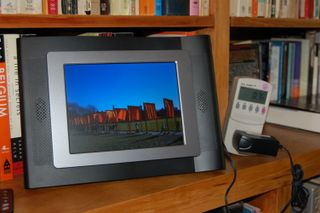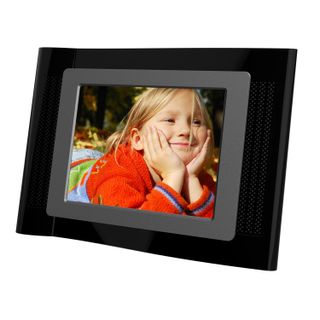Digital Picture Frame Vs. Photo Album
For Mother’s Day, should you get your mom a photo album or a digital picture frame? Which is more enjoyable, and which is greener? We measure and find out.
HP Smart WiFi Display
HP’s Smart WiFi Display is more than a digital picture frame because it has the ability to not only show pictures but tap into the Internet for a variety of media. At $120, it is expensive and uses a lot of electricity compared to a static album, but the Smart Display is worth every penny if you want a frame that can do a lot.
While other frames are one trick ponies that display images and nothing else, the Smart Display is the equivalent of a media center that you put on an end table or desk. At 8.9 by 11.2 by 1.8 inches it mimics the size and shape of a static picture frame, but the Smart Display has an 8-inch LCD screen and stereo speakers.
Its display is bright and rich, but the 800 by 600 screen has a lower resolution than many other frames and pales in comparison to a professionally made print. I like the frame’s fold-out easel, allowing it to sit horizontally or vertically. It can also be hung on a wall. There is one big snag, however: you’ll need to plug it in and hide the power cord.
The key is that on top of having 512MB of memory inside (enough for about 500 im
ages), the Smart Display has a flash card slot that can accommodate Secure Digital, CompactFlash, Memory Stick and xD modules. This opens up gigabytes of potential storage. It can also use WiFi networking to connect with a networked computer, but the frame can only work with 802.11b and g networks, not the newer 802.11n systems.

Unfortunately, the frame can only get content from one source one at a time so you can’t intersperse items from the different sources. It’s great for grabbing images off of a networked PC, but it has to use Windows Media Player 11 software.
It worked like a charm, showing .jpg images, .mpg videos as well as playing .mp3 and .wma music files. It can’t show .html Web pages or .pdf Acrobat files but is a versatile way to show off your media.
The frame connected to my 802.11g network on the first try, although using the tiny handheld remote to enter my encryption key was a bit awkward. I was able to get images from my 12GB of digital images and show them in order, shuffle them or display four at once. The frame stayed connected 95 feet from my router, giving it enough range for covering the typical apartment or house.
I used the frame for about a month and found it to be mesmerizing, particularly for children who often can’t take their eyes off of it, waiting for new photos to appear. The Smart Display isn’t as smart as it wants to be, because its transitions are choppy.

As far as energy use goes, it consumes 7 watts, or about what a child’s nightlight uses. It adds up to 61.3 kilowatt hours of electricity per year if left on all the time. According to the EPA’s carbon calculator that’s $6.74 added to you power bill and is the equivalent of 97 pounds of carbon pumped into the atmosphere of an already overheating planet. It is the effect of driving an extra 98 miles in a car that gets 20 miles per gallon.
To cut its power use, I can set it to only be on when there’s likely to be someone around to see it. Like an alarm clock it will wake up at its appointed time, but only reduces its power draw by 2 watts, making it hardly worth the effort.
All told, the HP Smart WiFi Display is a marvel of modern electronics that does so much that it leaves traditional picture frames in the dust.
$120
4.5 Stars

+ Web connectivity
+ Works with images, video and music that’s local or on the Internet
+ Remote control
+ Attractive design
- Small, low resolution screen
- Choppy transitions
- Expensive
- 802.11b/g only
Sign up to get the BEST of Tom's Guide direct to your inbox.
Get instant access to breaking news, the hottest reviews, great deals and helpful tips.
Brian Nadel is a freelance writer and editor who specializes in technology reporting and reviewing. He works out of the suburban New York City area and has covered topics from nuclear power plants and Wi-Fi routers to cars and tablets. The former editor-in-chief of Mobile Computing and Communications, Nadel is the recipient of the TransPacific Writing Award.
-
cadder Are any of these frames battery powered? I would like to have one to carry to family events to pass around.Reply -
bri-guy I've seen the Philips 7ff1cmi, which has a rechargeable battery but I don't think that it lasts for than a few hours.Reply
BN -
JohnnyLucky Girlfriend received a digital photo frame from her daughter last year. It was pre-loaded with photos of the grandchildren. First few days there was an initial wow factor. After that it just sat there turned off. I don't think my girlfriend has turned it on for an entire year.Reply -
bri-guy I can see that happening. I've had a frame running behind my desk for about a month, cycling through my photos and I kind of like glancing over to it every once in a while. I've been startled by some of the pictures that I haven't seen in decades. It's a nice time machine.Reply
bn -
tomate2 since you mentioned about not taking into account all the environmental impacts of making a photo album i guess who should talk about the environmental impacts of making a digital frame?? like the part of it being made by cheap labor outside of the us... the man work to keep digging up all those materials to START making a digital frame... or the bit extra electricity your using on the digital frame which comes from burning fossil fuels or flooding huge regions to build a dam... i guess you get the idea.. :DReply -
bri-guy Not justt that, but all the oil and natural gas that goes into the plastics, glass and silicon. Then, there's what to do with it after its ten (hopefully more) year life span is over and it's time to chuck it. There are times I wish I were an economist to untangle these questions. While researching the story I asked several experts in photography, including those who specialize in green photography, and none could even start to answer the question.Reply
BN -
wtlloyd Just in terms of volume of materials used, it's clear, to me at least, that if every household had an 8x10 digital photo frame, vrs every household owning a dedicated photo printer along with attendant ink cartridges, boxes of inkjet paper...the waste stream is continuous with a photo printer.Reply
The digital photo frame is clearly the way photo display is moving. Excitement over the IPad in Fine Art photography circles is over it's use as a portfolio. Recent industry pundit articles (Thomas Hogan) discussing "whither cameras" argue that the next development required to restart sales (the market is reaching saturation, and digicams are about to be made obsolete with improved camera phones) will be the communication (digital) between the photo making device and the storage and display devices.
Finally, referring to professionally printed photos vrs digital photo frames is a false argument...Fine art printing, with color balancing, tonal corrections, localized adjustments, and color managed output, is hardly typical of what you get when you send your snapshots off to Costco or wherever...Better pictures result from becoming a better photographer, not whether output is displayed on paper or screen. -
DianeJones I prefer a scapbook. A traditional photo album just doesn't have the same "wow" factor as flipping through pages of photos and memorabilia attractively displayed in a scapbook. I find that sitting a watching a digital photo frame for 15-30 minutes is very tedious.Reply
I am currently making a scrapbook for my son's graduation and have decided that when I finish that I will move on to doing other family albums so that I may enjoy the pictures instead of just packing them away in boxes. I do like the idea of a digital photo frame for a desk at work: I may check into that.
You can get 4x6 prints of digital photos from CVS for 19 cents each. I upload them from my computer and pick them up in the store. -
Another option is to put your photos in a photo book, a service offered online by many companies. They produce a hardback coffee table book with up to 84 pages holding up to 4 photos per page on photo paper.Reply
This uses no electricity and can be passed around for viewing unlike a digital frame. A portable DVD plater which is battery powered will usually display jpeg photos form a card or CD. -
joneb Erm theres somethig wrong in this article. if a digital photoframe was used like a photoalbum it wouldnt be on all the time but only when used. If the proper comparison was made what then would be the difference. I agree for photos displayed constantly prints seem definitely more environmentally friendly. But then if you have a laptop or a netbook you dont need the photoframe do you?Reply
